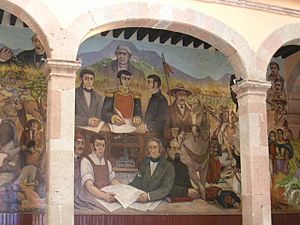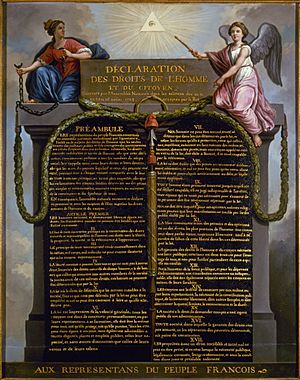Constitutional Elements (Mexico) facts for kids
The Constitutional Elements were important ideas for a new country. They were like a first draft of a constitution for Mexico, which was then called New Spain. General Ignacio López Rayón wrote them in April 1812, during the Mexican War of Independence. These ideas were shared on September 4, 1812, in Zinacantepec, State of Mexico. Their main goal was to help Mexico become a nation free from Spain. These "Elements" are seen as the starting point for the Sentimientos de la Nación by José María Morelos. They also led to the Constitution of 1824. This makes them the oldest example of Mexico's journey to having its own laws and government.
Contents
How the Constitutional Elements Came About
Why Mexico Needed New Laws
When the fight for independence started, Spain's King Ferdinand VII was removed from power by Napoleon Bonaparte. This left a big power gap. The Mexican rebels wanted to make their fight for freedom legal and fair. They needed a strong set of rules to unite everyone. These rules would help them build a new nation.
Other countries like France and the United States had already written their own constitutions. The U.S. Constitution was written in 1787. These examples inspired the Mexican rebels. They wanted a document that listed basic rights and principles for a new government. This would create authority even without a king. Spain itself was also working on a constitution, which became the Cadiz Constitution of 1812.
The Zitácuaro Council and Rayón's Role

During the Independence War, the Spanish rulers in New Spain were not recognized. So, on August 19, 1811, a group called the Supreme National American Meeting was formed. It was also known as the Junta de Zitácuaro. This meeting happened in Zitácuaro, Michoacán. It became the main governing body for the future Mexican nation. Key rebel leaders like José María Morelos and Ignacio López Rayón were part of it. Both were chosen as members of the Junta. Rayón was even named the Universal Minister of the Nation. Later, the Junta moved to Sultepec, in the State of Mexico.
López Rayón then started writing a draft constitution. He called it Elementos Constitucionales (Constitutional Elements). This document was meant to be approved by the Junta later. We don't know the exact date he wrote it. But a letter to Morelos shows it was created by April 30, 1812. By the summer of that year, it was already being shared. It seems the document was signed in Zinacantepec.
Morelos's Ideas and Changes
Rayón sent his first draft of the "Elements" to Morelos on April 30, 1812. Morelos was in Puebla at the time. Morelos's reply didn't arrive until November 7 of the same year. He said there was a delay. In his letter, Morelos suggested some changes to the "Elements." He wanted to remove any mention of King Ferdinand VII's power.
Morelos wrote:
[...] since what happened to this great man is so well known, it is necessary to leave him out to give the public the Constitution.
Morelos had already shared his view on Ferdinand VII in an earlier letter to Rayón:
This is my opinion, and the mask of Independence should be removed, because everyone knows what happened to our Ferdinand VII.
Morelos also suggested having a "National Protector" for each bishopric, chosen every four years. Rayón had proposed only one. Morelos also had ideas about how to organize the army.
These suggestions from Morelos were not added directly into the main text. Instead, they were put at the end of the document. This showed that Morelos had contributed to the ideas.
The ideas in the Constitutional Elements were very important. José María Morelos y Pavón knew them well. They likely influenced the final version of the Sentimientos de la Nación in 1813. Later, many of these ideas were included in the Constitution of Apatzingán of 1814. Rayón also helped write that constitution. It shares many similarities with the rights mentioned in the "Elements."
What the Constitutional Elements Included
The document starts with an introduction. It praises the fairness and rightness of America's independence. It also states that power belongs to the people:
«We, therefore, have the great satisfaction and honor of being chosen by the free people of our country to form the Supreme Court of the Nation and to represent the power that belongs only to them».
The main part of the Constitutional Elements has 38 statements, like articles. They contain the main ideas for creating an independent state, as wanted by the rebels:
- The Catholic religion would be the only official religion (Articles 1, 2, and 3).
- America would be independent (Article 4).
- Power comes from the people, but it would still be linked to King Ferdinand VII (Article 5).
- The use of power should aim for the nation's independence and happiness (Article 6).
- A Supreme National Congress would hold the power (Articles 5, 7 to 16).
- A "National Protector" would be chosen as the leader of the government (Article 17).
- There would be three branches of government: the leader (Executive), the lawmakers (Legislature), and the judges (Judiciary) (Article 21).
- Slavery and the caste system (social classes based on birth) would be banned (Articles 24 and 25).
- Citizens would have civil rights (Articles 29 to 32).
- September 16 would be a national holiday (Article 33).
- Rules for organizing the military (Articles 33 to 38).
The draft ends with a thought about the past of the American people. It says they were "forgotten by some, pitied by others and looked down on by most." It then looks to a more hopeful future. This future would have full equality among people. It says "cowardice and laziness will be the only things that shame a citizen." It also includes a religious message: "bless the God of destinies who has chosen to look with kindness on his people."
In a later version, this ending thought became a strong speech. It was followed by the changes Morelos had suggested.
The Ideas Behind the Elements
Influences on Rayón's Thinking

The Constitutional Elements show the deep thinking of Mexican liberals at the time. They were influenced by European thinkers like Locke, Hobbes, Montesquieu, Voltaire, and Rousseau. Spanish thinkers like Suárez and Vitoria also played a role. Ideas from American thinkers like Francisco Javier Clavijero, Fray Servando Teresa de Mier, and Francisco Javier Alegre were also important. Their writings were read in New Spain during the 1700s. The ideas from the French Revolution and American constitutions also strongly shaped Mexican thought.
During the time of independence in America, some key political ideas guided the movement:
- Enlightened absolutism: A system where a ruler has absolute power but uses it for the good of the people.
- Constitutionalism: Creating a government based on a constitution that recognizes individual rights.
- Democracy: A system where the people hold the power.
- Jeremy Bentham's utilitarianism: The idea that actions should aim for the greatest good for the greatest number of people.
These ideas are found in the Constitutional Elements. Rayón, with his legal background, included them. However, it's likely that the main ideas came from Miguel Hidalgo y Costilla himself. Rayón was Hidalgo's assistant and secretary. Morelos mentioned this in his letter to Rayón on November 7, 1812:
«Until now I had not received the Constitutional Elements: I have seen them and, with little difference, they are the same as the ones we discussed with Mr. Hidalgo».
Key Ideas and Their Legacy
One important idea in the "Elements" was Rayón's loyalty to King Ferdinand VII (Article 5). This caused some disagreement with Morelos, who wanted America to be completely free. But at the same time, Rayón supported Rousseau's idea that power belongs to the people. This idea was later included in the Constitution of Apatzingán. It has remained in Mexico's laws, even in the current Mexican Constitution of 1917. Article 39 of that constitution states:
«National sovereignty resides essentially and originally in the people. All public power comes from the people and is created for their benefit. The people always have the right to change or modify their form of government».
Rayón also believed in the democratic idea that a congress should exercise power. In this case, it was the Supreme American National Congress.
Article 31 of the Constitutional Elements talks about protecting homes. It mentions the "celebrated Corpus huves Act of England." This refers to the Habeas Corpus Act of 1640. This English law protected individual freedom from unfair arrest, even by the Crown, if there was no court order. This shows Rayón knew about English law. According to Soberanes Fernández, the Constitutional Elements are the earliest example of the Mexican amparo trial. The amparo trial protects citizens' rights from government actions.
The "Elements" also showed some religious intolerance (Articles 1 and 2). It made Catholicism the official State religion. This meant there was no freedom of other beliefs. Freedom of religion would not become part of Mexico's laws until the Constitution of 1857.
The ideas of liberty and equality for all citizens were central to French liberalism. The "Elements" showed liberty by banning slavery (Article 24). Equality was shown by removing the idea of lineages (social status based on family history) in Article 25.
Whoever was born after the happy independence of our Nation, will only be held back by personal flaws, without their family background being able to stop them. [...]
Finally, freedom of the press was established in Article 29. This was an early step towards the freedom of expression, thought, and press that would later be granted in Article 40 of the Constitution of Apatzingán.
See also
 In Spanish: Elementos Constitucionales para niños
In Spanish: Elementos Constitucionales para niños
- List of constitutions of Mexico
- Constitution of Mexico
- Natural law
- Liberalism
- New Spain

